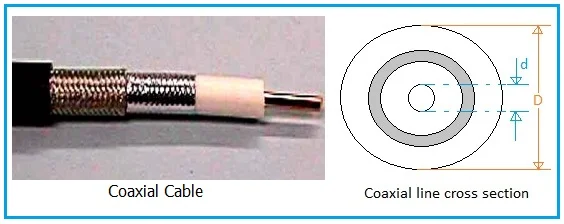Coaxial cable is used to transmit RF energy from one port or component to other ports/parts of the system. Standard coaxial cable is used as microwave coaxial line. This form of wire usually has two conductors in a cylindrical shape around a common axis. They are all separated by dielectric material. At lower frequencies, a polyethylene form is used as the dielectric, and at higher frequencies Teflon material is used.
Type of coaxial cable
There are many forms of coaxial cable depending on the conductor construction and shielding methods used. Coaxial cable types include standard coaxial cable as described above as well as gas-filled coaxial cable, articulated coaxial cable, and bi-wire shielded coaxial cable.
Flexible coaxial cables are used in television broadcast receiving antennas with outer conductors made of foil or braid.
At microwave frequencies, the outer conductor is rigid and the dielectric will be solid. In gas-filled coaxial cables, the center conductor is made of a thin ceramic insulator, also using polytetrafluoroethylene. Dry nitrogen can be used as a dielectric material.
In articulated coax, the inner insulator is raised around the inner conductor. around the shielded conductor and around this protective insulating sheath.
In double-shielded coaxial cable, two layers of protection are typically provided by providing an inner shield and an outer shield. This protects the signal from EMI and any radiation from the cable affecting nearby systems.
Coaxial line characteristic impedance
The characteristic impedance of a basic coaxial cable can be determined using the following formula.
Zo = 138/sqrt(K) * Log(D/d) Ohms
in,
K is the dielectric constant of the insulator between the inner and outer conductors. D is the diameter of the outer conductor and d is the diameter of the inner conductor.
Advantages or Advantages of Coaxial Cable

Following are the advantages or advantages of coaxial cable:
➨Due to the skin effect, coaxial cables used in high frequency applications (>50 MHz) use copper cladding of the center conductor. The skin effect is the result of high frequency signals propagating along the outer surface of a conductor. It increases the tensile strength of the cable and reduces weight.
➨Coaxial cable costs less.
➨The outer conductor in coaxial cable is used to improve attenuation and shielding. This is accomplished by using a second foil or braid called a sheath (designated C2 in Figure 1). The jacket serves as an environmental shield and is made into the integral coaxial cable as a flame retardant.
➨It is less susceptible to noise or interference (EMI or RFI) than twisted pairing cables.
➨Compared with twisted pair, it supports high-bandwidth signal transmission.
➨Easy to wire and expand due to flexibility.
➨It allows high transmission rate, coaxial cable has better shielding material.
Disadvantages or Disadvantages of Coaxial Cable
The following are the disadvantages of coaxial cable:
➨Big size.
➨Long distance installation is costly due to its thickness and stiffness.
➨Since a single cable is used to transmit signals throughout the network, if one cable fails, the entire network will go down.
➨Security is a big concern as it is easy to eavesdrop on the coaxial cable by breaking it and inserting a T-connector (BNC type) between the two.
➨Must be grounded to prevent interference.
Post time: Dec-15-2023







